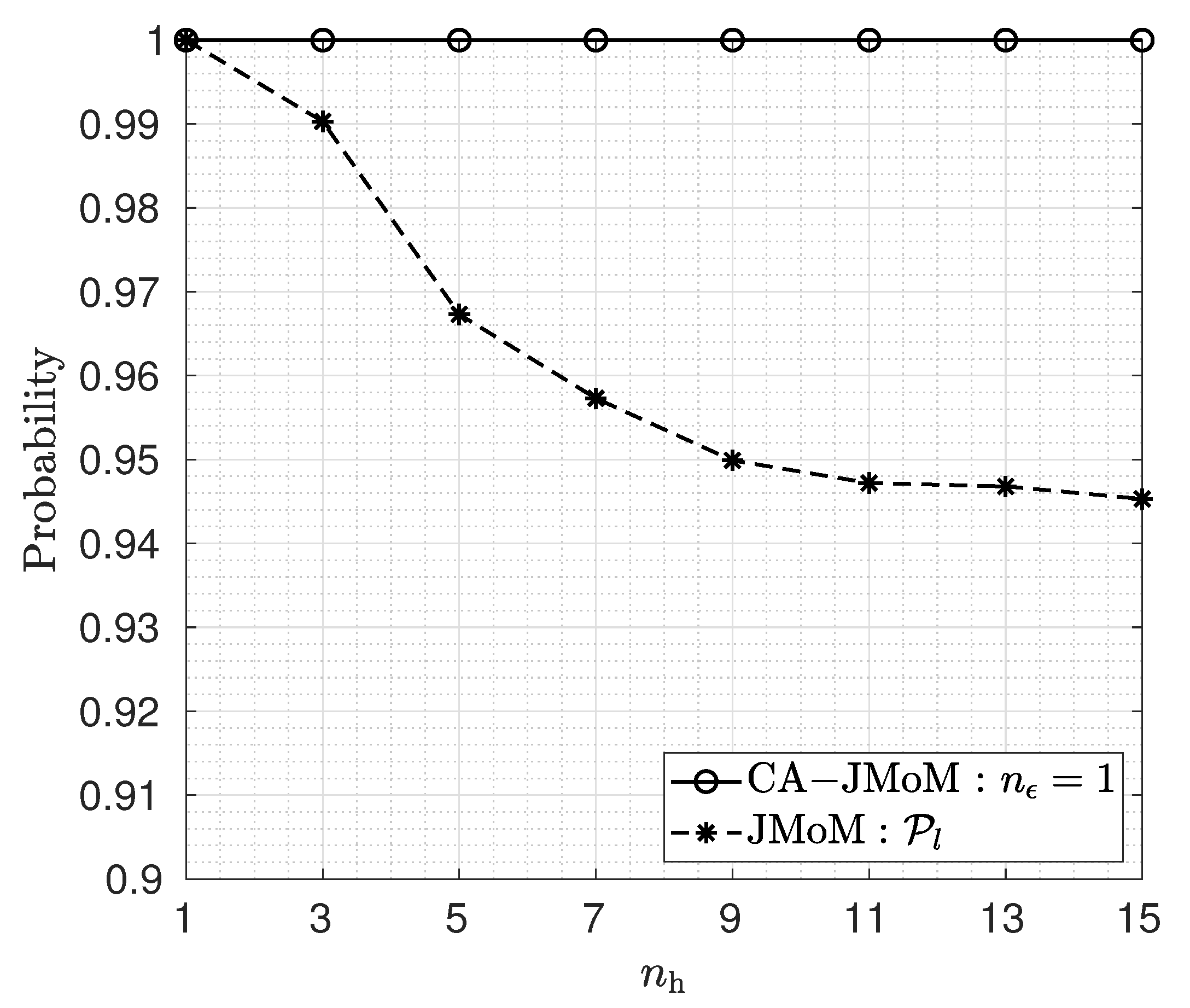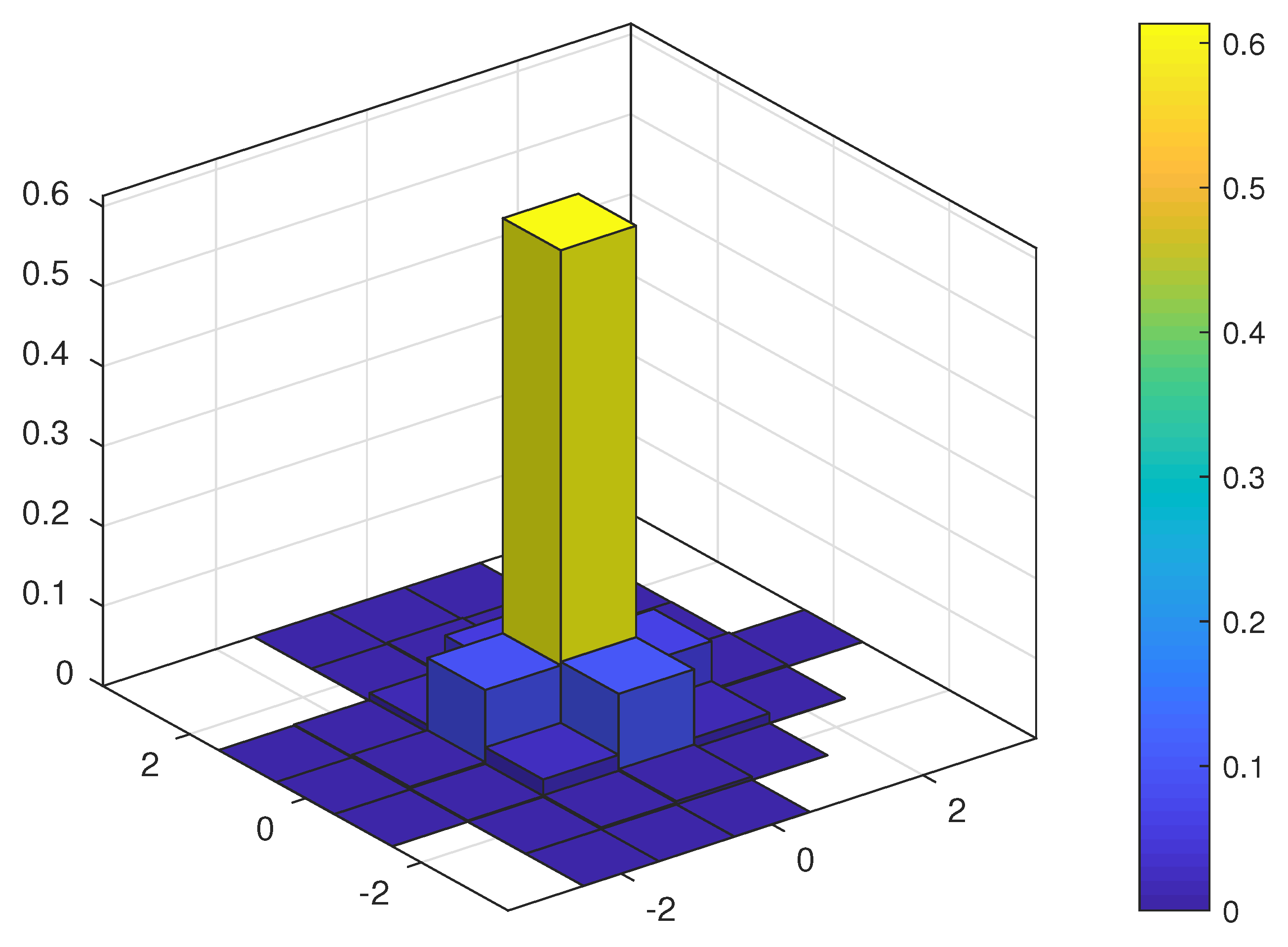Joint Method of Moments (JMoM) and Successive Moment Cancellation (SMC) Multiuser Time Synchronization for ZP-OFDM-Based Waveforms Applicable to Joint Communication and Sensing
Abstract
1. Introduction
2. Materials and Methods
2.1. System Model
2.2. JMoM TO Estimator
2.3. Successive Moment Cancellation (SMC) TO Estimator
| Algorithm 1 SMC |
|
2.4. Coding-Assisted (CA) Estimator for Fast TO Estimation
| Algorithm 2 CA-SMC |
| Step 1: |
|
| Step 2: |
|
2.5. Computational Complexity Analysis
2.6. Extension to Multiple Antennas
3. Simulations
3.1. Default Simulation Setup
3.2. Simulation Results
4. Conclusions
Author Contributions
Funding
Institutional Review Board Statement
Informed Consent Statement
Data Availability Statement
Acknowledgments
Conflicts of Interest
References
- Liu, F.; Cui, Y.; Masouros, C.; Xu, J.; Han, T.X.; Eldar, Y.C.; Buzzi, S. Integrated Sensing and Communications: Towards Dual-functional Wireless Networks for 6G and Beyond. IEEE J. Sel. Areas Commun. 2022, 40, 1728–1767. [Google Scholar] [CrossRef]
- Aydogdu, C.; Keskin, M.F.; Garcia, N.; Wymeersch, H.; Bliss, D.W. RadChat: Spectrum Sharing for Automotive Radar Interference Mitigation. IEEE Trans. Intell. Transp. Syst. 2019, 22, 416–429. [Google Scholar] [CrossRef]
- Dokhanchi, S.H.; Barreto, A.N.; Fettweis, G. A Half-duplex Joint Communications and Sensing System using ZP-OFDM. In Proceedings of the 2022 2nd IEEE International Symposium on Joint Communications & Sensing (JC&S), Seefeld, Austria, 9–10 March 2022; IEEE: New York, NY, USA, 2022; pp. 1–6. [Google Scholar]
- Liu, Z.; Quan, Y.; Wu, Y.; Xing, M. Super-Resolution Range and Velocity Estimations for SFA-OFDM Radar. Remote Sens. 2022, 14, 278. [Google Scholar] [CrossRef]
- Wang, J.; Wang, P.; Zhang, R.; Wu, W. SDFnT-Based Parameter Estimation for OFDM Radar Systems with Intercarrier Interference. Sensors 2023, 23, 147. [Google Scholar] [CrossRef]
- Shi, Q.; Zhang, T.; Yu, X.; Liu, X.; Lee, I. Time Domain IRCI-Free Pulse Compression for OQAM-OFDM Radar System. IEEE Syst. J. 2022, 16, 6480–6489. [Google Scholar] [CrossRef]
- Noh, H.; Lee, H.; Yang, H.J. ICI-Robust Transceiver Design for Integration of MIMO-OFDM Radar and MU-MIMO Communication. IEEE Trans. Veh. Technol. 2022, 72, 821–838. [Google Scholar] [CrossRef]
- Pham, T.M.; Barreto, A.N.; Fettweis, G.P. Efficient Communications for Overlapped Chirp-based Systems. IEEE Wirel. Commun. Lett. 2020, 9, 2202–2206. [Google Scholar] [CrossRef]
- Lee, S.; Kim, K.; Lee, K.; Cho, S.; Choi, S.U.; Lee, J.; Koo, B.T.; Song, H.J. An E-band CMOS Direct Conversion IQ Transmitter for Radar and Communication Applications. In Proceedings of the 2022 IEEE Radio Frequency Integrated Circuits Symposium (RFIC), Denver, CO, USA, 19–21 June 2022; IEEE: New York, NY, USA, 2022; pp. 111–114. [Google Scholar]
- An, S.; Bu, X.; Wymeersch, H.; Zirath, H.; He, Z.S. Millimeter-Wave Multi-Channel Backscatter Communication and Ranging with an FMCW Radar. Sensors 2022, 22, 7104. [Google Scholar] [CrossRef]
- Muquet, B.; Wang, Z.; Giannakis, G.B.; de Courville, M.; Duhamel, P. Cyclic Prefixing or Zero Padding for Wireless Multicarrier Transmissions? IEEE Trans. Commun. 2002, 50, 2136–2148. [Google Scholar] [CrossRef]
- Mashhadi, M.B.; Gündüz, D. Pruning the Pilots: Deep Learning-based Pilot Design and Channel Estimation for MIMO-OFDM Systems. IEEE Trans. Wirel. Commun. 2021, 20, 6315–6328. [Google Scholar] [CrossRef]
- Kang, X.F.; Liu, Z.H.; Yao, M. Deep Learning for Joint Pilot Design and Channel Estimation in MIMO-OFDM Systems. Sensors 2022, 22, 4188. [Google Scholar] [CrossRef] [PubMed]
- Zhao, L.; Guo, W.; Liu, Y.; Yang, J.; Wang, W. Pilot Optimization for OFDM-based OTFS Systems over Doubly Selective Channels. In Proceedings of the GLOBECOM 2020-2020 IEEE Global Communications Conference, Taipei, Taiwan, 7–11 December 2020; pp. 1–6. [Google Scholar]
- Athisaya Anushya, T.; Laxmikandan, T.; Manimekalai, T. Zero Padded Dual Index Trimode OFDM-IM. In Proceedings of the 2022 International Conference on Wireless Communications Signal Processing and Networking (WiSPNET), Chennai, India, 24–26 March 2022; IEEE: New York, NY, USA, 2022; pp. 94–98. [Google Scholar]
- Neelam, S.G.; Sahu, P. Digital Compensation of IQ Imbalance, DC Offset for Zero-Padded OTFS Systems. IEEE Commun. Lett. 2022, 26, 2450–2454. [Google Scholar] [CrossRef]
- Thaj, T.; Viterbo, E. Low Complexity Iterative Rake Decision Feedback Equalizer for Zero-padded OTFS Systems. IEEE Trans. Veh. Technol. 2020, 69, 15606–15622. [Google Scholar] [CrossRef]
- Karpovich, P.; Zielinski, T.P. Random-Padded OTFS Modulation for Joint Communication and Radar/Sensing Systems. In Proceedings of the 2022 23rd International Radar Symposium (IRS), Gdansk, Poland, 12–14 September 2022; IEEE: New York, NY, USA, 2022; pp. 104–109. [Google Scholar]
- Le Nir, V.; van Waterschoot, T.; Duplicy, J.; Moonen, M. Blind Coarse Timing Offset Estimation for CP-OFDM and ZP-OFDM Transmission over Frequency Selective Channels. EURASIP J. Wirel. Commun. Netw. 2010, 2009, 262813. [Google Scholar] [CrossRef]
- Roshandeh, K.P.; Mohammadkarimi, M.; Ardakani, M. Maximum Likelihood Time Synchronization for Zero-Padded OFDM. IEEE Trans. Signal Process. 2021, 69, 641–654. [Google Scholar] [CrossRef]
- Roshandeh, K.P.; Mohammadkarimi, M.; Ardakani, M. Low Complexity Time Synchronization for Zero-padding based Waveforms. arXiv 2023, arXiv:2303.07453. [Google Scholar]
- Ahmed, M.; Khan, W.U.; Ihsan, A.; Li, X.; Li, J.; Tsiftsis, T.A. Backscatter Sensors Communication for 6G Low-powered NOMA-enabled IoT Networks under Imperfect SIC. IEEE Syst. J. 2022, 16, 5883–5893. [Google Scholar] [CrossRef]
- Ihsan, A.; Chen, W.; Asif, M.; Khan, W.U.; Wu, Q.; Li, J. Energy-efficient IRS-aided NOMA beamforming for 6G Wireless Communications. IEEE Trans. Green Commun. Netw. 2022, 6, 1945–1956. [Google Scholar] [CrossRef]
- Liu, Y.; Zhang, S.; Mu, X.; Ding, Z.; Schober, R.; Al-Dhahir, N.; Hossain, E.; Shen, X. Evolution of NOMA toward Next Generation Multiple Access (NGMA) for 6G. IEEE J. Sel. Areas Commun. 2022, 40, 1037–1071. [Google Scholar] [CrossRef]
- Oleiwi, H.W.; Al-Raweshidy, H. Cooperative SWIPT THz-NOMA/6G Performance Analysis. Electronics 2022, 11, 873. [Google Scholar] [CrossRef]
- Morelli, M.; Kuo, C.C.J.; Pun, M.O. Synchronization techniques for orthogonal frequency division multiple access (OFDMA): A tutorial review. Wirel. Commun. Mob. Comput. 2007, 95, 1394–1427. [Google Scholar] [CrossRef]
- Jiang, T.; Wu, Y. An overview: Peak-to-average Power Ratio Reduction Techniques for OFDM Signals. IEEE Trans. Broadcast. 2008, 54, 257–268. [Google Scholar] [CrossRef]
- Cheng, H.; Xia, Y.; Huang, Y.; Yang, L. Improper Gaussian Signaling for Downlink NOMA Systems With Imperfect Successive Interference Cancellation. IEEE Trans. Wirel. Commun. 2022, 21, 7753–7763. [Google Scholar] [CrossRef]
- Fanari, L.; Iradier, E.; Bilbao, I.; Cabrera, R.; Montalban, J.; Angueira, P.; Seijo, O.; Val, I. A Survey on FEC Techniques for Industrial Wireless Communications. IEEE Open J. Ind. Electron. Soc. 2022, 3, 674–699. [Google Scholar] [CrossRef]









| Metric | JMoM | SMC | CA-JMoM | CA-SMC |
|---|---|---|---|---|
| Complexity | + | + |
Disclaimer/Publisher’s Note: The statements, opinions and data contained in all publications are solely those of the individual author(s) and contributor(s) and not of MDPI and/or the editor(s). MDPI and/or the editor(s) disclaim responsibility for any injury to people or property resulting from any ideas, methods, instructions or products referred to in the content. |
© 2023 by the authors. Licensee MDPI, Basel, Switzerland. This article is an open access article distributed under the terms and conditions of the Creative Commons Attribution (CC BY) license (https://creativecommons.org/licenses/by/4.0/).
Share and Cite
Pourtahmasi Roshandeh, K.; Mohammadkarimi, M.; Ardakani, M. Joint Method of Moments (JMoM) and Successive Moment Cancellation (SMC) Multiuser Time Synchronization for ZP-OFDM-Based Waveforms Applicable to Joint Communication and Sensing. Sensors 2023, 23, 3660. https://doi.org/10.3390/s23073660
Pourtahmasi Roshandeh K, Mohammadkarimi M, Ardakani M. Joint Method of Moments (JMoM) and Successive Moment Cancellation (SMC) Multiuser Time Synchronization for ZP-OFDM-Based Waveforms Applicable to Joint Communication and Sensing. Sensors. 2023; 23(7):3660. https://doi.org/10.3390/s23073660
Chicago/Turabian StylePourtahmasi Roshandeh, Koosha, Mostafa Mohammadkarimi, and Masoud Ardakani. 2023. "Joint Method of Moments (JMoM) and Successive Moment Cancellation (SMC) Multiuser Time Synchronization for ZP-OFDM-Based Waveforms Applicable to Joint Communication and Sensing" Sensors 23, no. 7: 3660. https://doi.org/10.3390/s23073660
APA StylePourtahmasi Roshandeh, K., Mohammadkarimi, M., & Ardakani, M. (2023). Joint Method of Moments (JMoM) and Successive Moment Cancellation (SMC) Multiuser Time Synchronization for ZP-OFDM-Based Waveforms Applicable to Joint Communication and Sensing. Sensors, 23(7), 3660. https://doi.org/10.3390/s23073660





